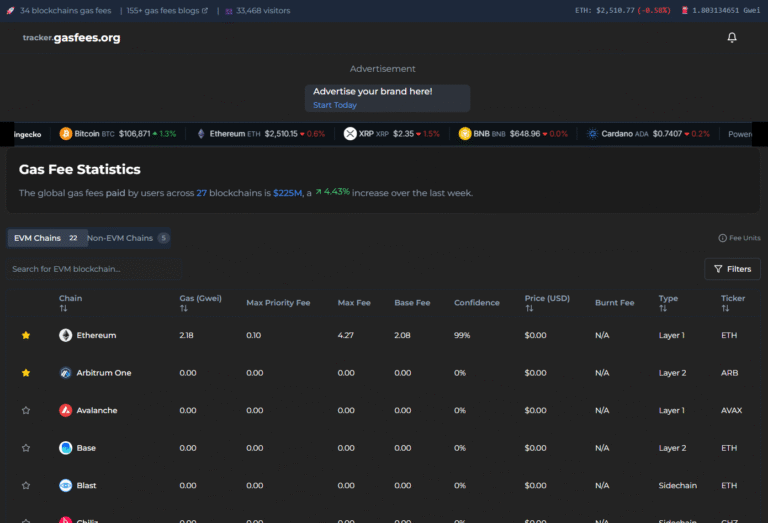
What are elastos gas fees?
However, Elastos operates sidechains, such as the Elastos Smart Chain (ESC), which supports Ethereum-compatible smart contracts. On the ESC, gas fees apply and are paid in ELA, but they are notably low—often less than $0.01 per transaction (around 3.3 Gwei), with options for fast (5s), normal (15s), or slow processing times. These fees cover computational resources and are kept minimal due to Elastos’ efficient architecture and merged mining with Bitcoin, which enhances security without inflating costs.
Users can monitor ESC gas fees using tools like Elastos’ block explorers or wallets like Elastos Essentials, which provide real-time fee estimates. By eliminating main chain gas fees and maintaining low sidechain costs, Elastos fosters a cost-effective environment for decentralized applications, making it attractive for developers and users alike.
Elastos, the ambitious platform aiming to build a “carrier internet” for distributed applications, takes a unique approach to transaction fees compared to other popular blockchains like Ethereum. Understanding how gas fees work in the Elastos ecosystem is crucial for users and developers alike. This article aims to demystify the concept and equip you with the knowledge to navigate the Elastos network efficiently.
Elastos: A Chain of Sidechains
Unlike Ethereum, which relies on a single mainnet for smart contracts, Elastos utilizes a network of sidechains built on top of its main chain. Each sidechain can have its own gas fee structure, independent of the main chain. This flexibility allows for tailored solutions and potentially lower fees for specific applications.
Main Chain: Transaction Fees, Not Gas Fees
On the Elastos main chain itself, there are actually no gas fees. Transactions primarily involve transferring the native ELA token, and network operations are powered by a different mechanism called DPoS (Delegated Proof of Stake). However, transferring ELA to and from sidechains does incur transaction fees on the main chain.
Sidechains: Where Gas Fee Action Happens
The action with gas fees is on the sidechains. Each sidechain can determine its own fee structure and gas unit, similar to Ethereum. For example, the Elastos ETH Sidechain uses gas fees similar to Ethereum but potentially at a lower cost due to its DPoS consensus mechanism. Other sidechains, like the NEO VM sidechain, might have different fee structures altogether.
Factors Affecting Gas Fees:
- Sidechain Design: The specific sidechain implementation and its consensus mechanism influence gas fees. DPoS generally offers lower fees than Proof of Work like Ethereum.
- Network Demand: Just like on Ethereum, increased demand for transactions on a sidechain can lead to higher gas fees due to limited computational resources.
- Transaction Complexity: Complex smart contracts and dApps typically consume more gas and incur higher fees compared to simpler operations.
Optimizing Your Gas Costs:
While gas fees exist on specific Elastos sidechains, you can still employ strategies to optimize your costs:
- Choose the Right Sidechain: Consider the gas fee structure of different sidechains when deciding where to execute your transactions. Sidechains designed for efficiency like the Elastos ETH Sidechain might be preferable for cost-conscious users.
- Time Your Transactions: Monitor network congestion and gas prices on your chosen sidechain. Off-peak hours often offer lower fees.
- Prioritize Efficiently: Some sidechains allow users to set a priority fee to expedite their transactions, but this comes at an additional cost. Weigh the urgency against the additional cost.
- Combine Transactions: Batching multiple small transactions into one can sometimes reduce the overall gas cost compared to processing them individually.
The Future of Elastos Gas Fees:
The Elastos development team is actively exploring solutions to further optimize gas fees across the network. This includes potential upgrades to sidechain protocols and the ongoing development of Layer 2 scaling solutions.
Conclusion:
While gas fees exist on Elastos sidechains, their structure and impact differ from mainstream blockchain platforms like Ethereum. Understanding this unique approach and employing optimization strategies can empower you to navigate the Elastos network effectively and make the most of its innovative sidechain ecosystem.
Additional Resources:
- Elastos Official Website: https://www.elastos.org/
- Elastos Developer Center: https://elastos-wiki.netlify.app/
- Elastos Community Forum: https://github.com/elastos/Elastos.Community




